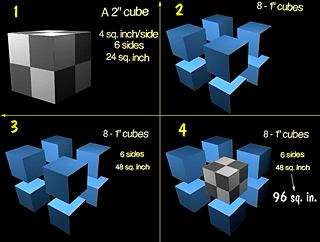Granite vs. Basalt
Granite contains large amounts of quartz which is almost inert to chemical weathering. The other minerals have many soluble ions, K+, Ca+2, Mg+2, and various iron species.
Basalt lacks the quartz but is made up primarily of the Ca+2, Mg+2, and iron containing minerals.
Both of these basic rock types chemically alter to clay minerals, and in the case of the more felsic minerals they leave behind unaltered quartz.
The decomposition of chemically alterable minerals can leave behind valuable concentrations of heavier elements. Gold occurs in only trace amounts in most rocks, but after weathering it is often separated from the entrapping material and ends up concentrating due to its high specific gravity.
Chemically weathering can produce economic deposits of heavy stable minerals. Gold, platinum, diamond, and any types of gemstones.
Weathering Rind
Rocks weather form the outside, in. Water starts at the surface and penetrates the spaces between crystals, and in any cracks in the surface. Slowly an exterior layer forms that has the weathered composition rather than the original composition. The new composition is caused by the leaching of material so the crust shrinks as material is lost.
This process will usually weaken the over all structure. And will increase the size of the external cracks in the material. The larger, deeper cracks then allow water to reach further into the surface and more (originally underlying) material is then effected.

Surface Area
Why is table salt sold in a granular form rather than in large blocks? Why is cattle salt-lick sold in large blocks rather than in a granular form?
The answer is related to the speed at which one desires it to be dissolved. The higher the surface area, the faster a body of water can dissolve it. If you think about it, a completely dissolved salt crystal has a maximum surface area, as there is water around each atom.
For this reason the speed at which a rock or mineral can be weathered is directly related to it composition and surface area.
Each time you subdivide a material, its surface area doubles.

| NEXT | TOC | PREV |